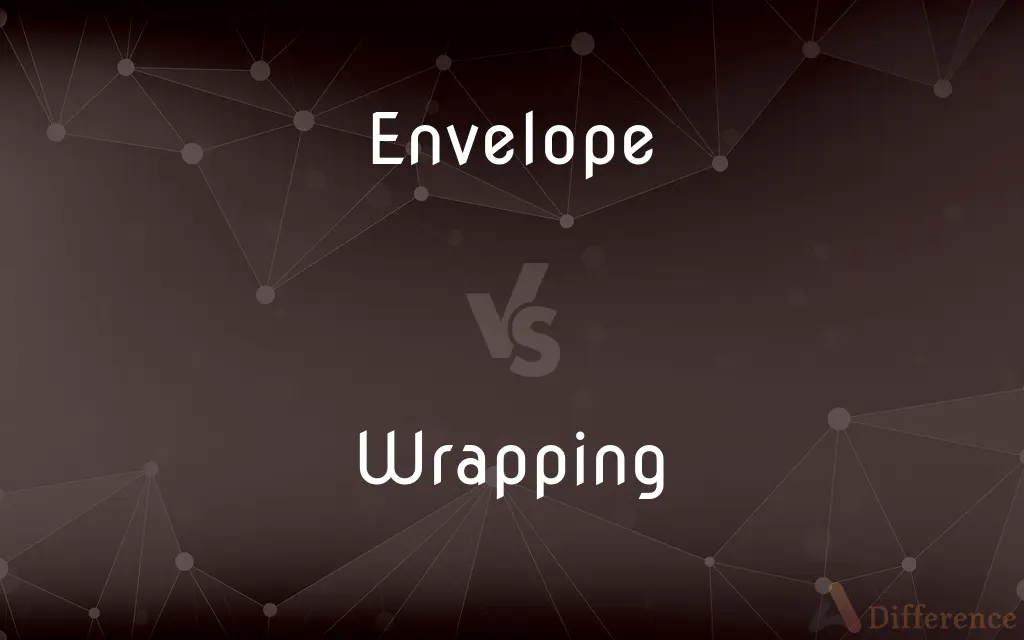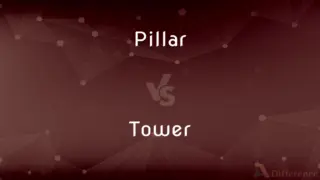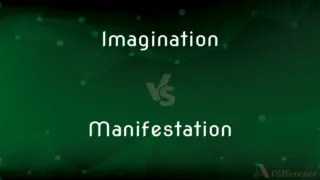Envelope vs. Wrapping — What's the Difference?
By Tayyaba Rehman & Fiza Rafique — Updated on April 16, 2024
Envelope is typically a flat, paper container for letters, while wrapping refers to any material used to encase and decorate a gift.

Difference Between Envelope and Wrapping
Table of Contents
ADVERTISEMENT
Key Differences
An envelope is designed primarily for enclosing documents, especially letters, providing privacy and protection during mailing. Wrapping, on the other hand, is used to conceal and beautify gifts, often adding a layer of surprise and celebration to the presentation.
Envelopes are usually made from paper and come in standard sizes that align with postal requirements. Whereas wrapping can be made from a variety of materials including paper, cloth, and plastic, tailored to the shape and size of the item being covered.
The primary function of an envelope is to ensure the secure and confidential transport of its contents. Wrapping, however, focuses on aesthetics and the act of gifting, emphasizing visual appeal and personalization.
Envelopes often feature a sealable flap that is used to keep the contents secure until they reach the recipient. Wrapping materials might use ribbons, tape, or ties to secure them around the gift, often requiring additional decorative elements like bows or tags.
While envelopes are commonly associated with formal communication and transactions, wrapping is linked with social rituals like birthdays, holidays, and weddings, highlighting cultural and personal significance.
ADVERTISEMENT
Comparison Chart
Material
Typically paper
Can be paper, plastic, cloth, etc.
Primary Use
Mailing documents
Decorating and concealing gifts
Function
Privacy and protection
Aesthetic enhancement and surprise
Closure
Sealable flap
Uses ribbons, tape, ties
Cultural Association
Formal communication and business transactions
Social events and personal celebrations
Compare with Definitions
Envelope
A protective covering for letters, designed to ensure confidentiality.
He wrote Confidential on the envelope.
Wrapping
Material used to cover or decorate a gift.
She chose a shiny red wrapping for the present.
Envelope
A metaphorical term in business to refer to pushing boundaries.
The new marketing strategy really pushed the envelope.
Wrapping
A means of concealing the identity of a gift.
The wrapping was so meticulous it was a shame to tear it.
Envelope
In physics, a curve or surface enveloping another figure.
The graph shows the envelope of the sine wave.
Wrapping
In culinary terms, a layer of food wrapped around another.
The chef prepared grape leaves as a wrapping for the rice.
Envelope
A flat, usually square or rectangular piece of paper that is sealed around a letter or document.
She placed the letter in an envelope and mailed it.
Wrapping
Used in a broader sense for any protective or insulating cover.
The pipes were secured with thermal wrapping.
Envelope
An item used in mailing for organizing and securing documents.
The legal documents were organized in a manila envelope.
Wrapping
In logistics, the act of enclosing items for shipment.
Effective wrapping is essential for item safety during transport.
Envelope
An envelope is a common packaging item, usually made of thin, flat material. It is designed to contain a flat object, such as a letter or card.
Wrapping
The material in which something is wrapped.
Envelope
A flat paper container with a sealable flap, used to enclose a letter or document.
Wrapping
The material in which something is wrapped.
Envelope
A covering or containing structure or layer
The external envelope of the swimming pool
Wrapping
Present participle of wrap
Envelope
A flat paper container, especially for a letter, usually having a gummed flap.
Wrapping
The covering (usually paper or cellophane) in which something is wrapped
Envelope
Something that envelops; a wrapping.
Wrapping
An enveloping bandage
Envelope
(Biology) An enclosing structure or cover, such as a membrane or the outer coat of a virus.
Envelope
The bag containing the gas in a balloon or airship.
Envelope
The set of limitations within which a technological system, especially an aircraft, can perform safely and effectively.
Envelope
A usually spherical region of interstellar matter surrounding a forming star and interacting with the star's gravitational and radiation fields.
Envelope
The coma of a comet.
Envelope
(Mathematics) A curve or surface that is tangent to every one of a family of curves or surfaces.
Envelope
A paper or cardboard wrapper used to enclose small, flat items, especially letters, for mailing.
Envelope
Something that envelops; a wrapping.
Envelope
A bag containing the lifting gas of a balloon or airship; fabric that encloses the gas-bags of an airship.
Envelope
(geometry) A mathematical curve, surface, or higher-dimensional object that is the tangent to a given family of lines, curves, surfaces, or higher-dimensional objects. Category:en:Curves
Envelope
(electronics) A curve that bounds another curve or set of curves, as the modulation envelope of an amplitude-modulated carrier wave in electronics.
Envelope
(music) The shape of a sound, which may be controlled by a synthesizer or sampler.
Envelope
(computing) The information used for routing a message that is transmitted with the message but not part of its contents.
Envelope
(biology) An enclosing structure or cover, such as a membrane; a space between two membranes
Envelope
(engineering) The set of limitations within which a technological system can perform safely and effectively.
Envelope
(astronomy) The nebulous covering of the head or nucleus of a comet; a coma.
Envelope
An earthwork in the form of a single parapet or a small rampart, sometimes raised in the ditch and sometimes beyond it.
Envelope
Archaic form of envelop
Envelope
That which envelops, wraps up, encases, or surrounds; a wrapper; an inclosing cover; esp., the cover or wrapper of a document, as of a letter.
Envelope
The nebulous covering of the head or nucleus of a comet; - called also coma.
Envelope
A work of earth, in the form of a single parapet or of a small rampart. It is sometimes raised in the ditch and sometimes beyond it.
Envelope
A curve or surface which is tangent to each member of a system of curves or surfaces, the form and position of the members of the system being allowed to vary according to some continuous law. Thus, any curve is the envelope of its tangents.
Envelope
A set of limits for the performance capabilities of some type of machine, originally used to refer to aircraft; - it is often described graphically as a two-dimensional graph of a function showing the maximum of one performance variable as a function of another. Now it is also used metaphorically to refer to capabilities of any system in general, including human organizations, esp. in the phrase push the envelope. It is used to refer to the maximum performance available at the current state of the technology, and therefore refers to a class of machines in general, not a specific machine.
Envelope
A flat rectangular paper container for papers
Envelope
Any wrapper or covering
Envelope
A curve that is tangent to each of a family of curves
Envelope
A natural covering (as by a fluid);
The spacecraft detected an envelope of gas around the comet
Envelope
The maximum operating capability of a system;
Test pilots try to push the envelope
Envelope
The bag containing the gas in a balloon
Common Curiosities
What is the purpose of the sealing flap on an envelope?
It secures the contents of the envelope, maintaining privacy and preventing loss during transit.
What is the primary material used for envelopes?
Envelopes are primarily made of paper.
What types of wrapping are commonly used for gifts?
Paper, cloth, and plastic are commonly used materials for gift wrapping.
Are envelopes recyclable?
Yes, most paper envelopes are recyclable unless they have plastic windows or metallic inlays.
How is wrapping paper designed to enhance the gift-giving experience?
Wrapping paper often features colorful designs and textures to make the gift-giving process more festive and exciting.
How do envelope sizes correlate with postal standards?
Envelope sizes are standardized to align with postal service regulations, facilitating easy handling and sorting.
What are some creative uses for leftover wrapping paper?
Leftover wrapping paper can be used for crafting, scrapbooking, or as drawer liners.
Can wrapping be reused?
Yes, materials like cloth and some durable papers are reusable.
Can wrapping be considered an art form?
Yes, the aesthetic design and technique involved in gift wrapping can elevate it to an art form, particularly in cultures where it is highly valued.
What is the significance of the security features in envelopes?
Security features like tamper-proof seals and opaque materials are designed to protect sensitive information from unauthorized access.
Is it possible to customize envelopes for business use?
Yes, businesses often customize envelopes with logos, return addresses, and branding elements for a professional appearance.
What are some eco-friendly alternatives to traditional gift wrapping?
Eco-friendly alternatives include reusable fabric wraps, recycled paper, and decorations using natural materials like twine or leaves.
What are the differences between window envelopes and regular envelopes?
Window envelopes have a transparent plastic window that allows addresses or information printed on the document inside to be visible without opening the envelope.
Are there any specific tools or accessories commonly used with wrapping?
Common tools include scissors, tape, ribbon cutters, and decorative stickers to enhance the appearance and secure the wrapping.
How should one choose the right type of envelope for a particular mailing?
Choose based on the size, weight, and confidentiality requirements of the contents, as well as the durability needed for transit.
Share Your Discovery

Previous Comparison
Pillar vs. Tower
Next Comparison
Imagination vs. ManifestationAuthor Spotlight
Written by
Tayyaba RehmanTayyaba Rehman is a distinguished writer, currently serving as a primary contributor to askdifference.com. As a researcher in semantics and etymology, Tayyaba's passion for the complexity of languages and their distinctions has found a perfect home on the platform. Tayyaba delves into the intricacies of language, distinguishing between commonly confused words and phrases, thereby providing clarity for readers worldwide.
Co-written by
Fiza RafiqueFiza Rafique is a skilled content writer at AskDifference.com, where she meticulously refines and enhances written pieces. Drawing from her vast editorial expertise, Fiza ensures clarity, accuracy, and precision in every article. Passionate about language, she continually seeks to elevate the quality of content for readers worldwide.
















































